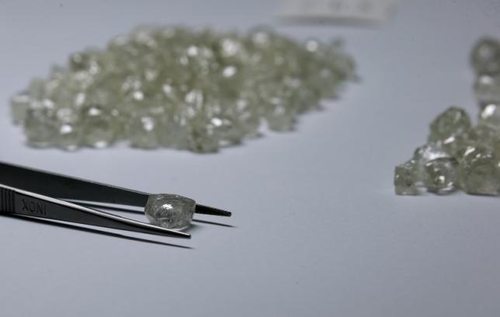Reuters
May 18, 2016
Best friends? Anglo keeps De Beers' diamonds
Reuters
May 18, 2016
Mining group Anglo American has retained De Beers as a prize asset after a radical overhaul in the belief that surging Chinese and Indian demand for diamonds will outstrip dwindling supply even after a 2015 crunch.

The group, in which Anglo American has an 85 percent stake, has seen its market share fall from over 80 percent in the 1980s to about a third now, losing it control of supply and unleashing price volatility.
Its challenges are compounded by competition from synthetic diamonds and uncertain demand from customers in the "millennial" generation, aged roughly 18 to 34.
Anglo has cut the value of De Beers assets in its books each year since 2012, after it had paid $5.1 billion (3.4 billion pounds) for a 40 percent stake.
But it remains the largest diamond producer by value ahead of Russia's Alrosa, securing access to top mines through close ties to countries such as Namibia, with which signed a 10-year sales deal this week, and Botswana.
It repeatedly points to growing wealth in China and India drawing in ever more consumers while output gradually declines from 2020.
This is the basis of Anglo American's case for retaining De Beers in a drastic overhaul. Bernstein Securities analyst Paul Gait says Anglo is seeking to make itself attractive to a buyer, although De Beers' ties with states and and joint ventures could make any sale complex.
"Most mining companies like diamonds," he said. "The basic reason why they've not been able to get bigger diamond positions speaks to the fundamental attractiveness of the industry."
SPECIAL "SIGHT" SALES
Anglo has steadily increased its disclosures on De Beers since its consolidation in 2012, with earlier annual report entries giving a broad overview of the business while the 2015 report offers greater detail on financials and its performance in different countries. It also now publishes the results of its periodic diamond sales.
Even so, diamonds are not traded on an open exchange and are vulnerable to consumer whim.
De Beers offers boxes of rough, or unpolished, diamonds to around 80 selected "sightholders" at sales known as "sights" -- but that cosy relationship loosened last year.
Global demand for diamond jewellery hit a high of $81 billion in 2014, but production jumped too, leaving the market flooded by 2015 just as Chinese retailers, such as Chow Tai Fook, stopped expanding.
"Sightholders couldn't make a profit and they gradually started refusing," said Christopher Germerchak, editor of The Diamond Loupe in Antwerp, where largely Jewish and Indian dealers clustered on three traffic-free streets represent the heart of the global diamond trade.
SYNTHETICS UNDERMINE
De Beers sees subdued prices in 2016, but production is likely to peak in 2017 after two Canadian mines come on stream.
However, diamonds are only scarce if you ignore laboratory-grown stones. Used largely in cutting tools, their share of diamond gem sales, though just 2-3 percent now, is growing.
"Producers can say a million times that it's not the same thing. That may have been so before, but it's not true any more. It's a diamond, full stop," said Chaim Even-Zohar, editor of Diamond Intelligence, who believes synthetics will erode the power of producers.
Lab-grown diamonds, such as those made by California's Diamond Foundry with Leonardo Di Caprio as a backer, typically trade at a modest discount to natural stones.
De Beers head of strategy, Gareth Mostyn, told Reuters De Beers was not ignoring the competition from synthetics but was clear on consumer preferences.
"If they have a choice between a diamond that was created three billion years ago by nature and one grown in a factory last week, customers want the real thing," he said.
75 MILLION NEW INDIAN BUYERS
De Beers says some 75 million new Indian households will see their incomes rise to $5,000-$6,000 per year in the next decade, a level at which they may start buying diamonds.
However, it needs to persuade them and younger "millennial" shoppers in the United States, the largest market, to buy.
De Beers used to pump $150-$200 million a year into generic diamond marketing, telling consumers a diamond was forever and making them the must-have gem for engagements.
"The diamond sector cannot take the demand curve for granted," said Anish Aggarwal, partner at consultancy Gemdax. Diamonds "are competing with holidays, gadgets, handbags, even cars" to tap the spending power of the millenials.
Aggarwal said seven major producers banded together a year ago to promote natural stones. With an initial $6 million budget, it plans to target the 'millenials' in Las Vegas next month.
Investec analyst Marc Elliott says diamond demand will logically grow as a late in the development cycle of economies such as China and India.
"Synthetics have a role to play... If they grow consumption in diamonds anywhere near what they did in other commodities, there won't be nearly enough diamonds from the ground to support that demand."
© Thomson Reuters 2024 All rights reserved.

























